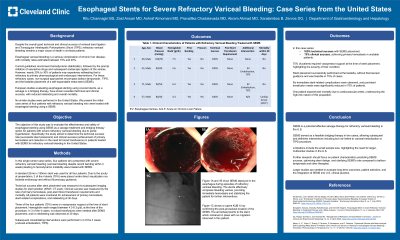Monday Poster Session
Category: Liver
P3086 - Esophageal Stents For Severe Refractory Variceal Bleeding: Case Series From the United States
Monday, October 28, 2024
10:30 AM - 4:00 PM ET
Location: Exhibit Hall E

Has Audio

Ritu Channagiri, BS
Cleveland Clinic Florida
Boca Raton, FL
Presenting Author(s)
Ritu Channagiri, BS1, Zaid Ansari, MD2, Ashraf Almomani, MD3, Pravallika Chadalavada, MD3, Akram Ahmad, MD3, Xaralambos B. Zervos, DO, MBA3
1Cleveland Clinic Florida, Boca Raton, FL; 2Cleveland Clinic Florida, Plantation, FL; 3Cleveland Clinic Florida, Weston, FL
Introduction: Despite the overall good technical and clinical success of variceal band ligation and Transjugular Intrahepatic Portosystemic Shunt (TIPS), refractory variceal bleeding remains a major cause of death in cirrhosis patients. European studies evaluating esophageal stenting using covered stents, as a salvage or a bridging therapy, have shown excellent technical and clinical success. No similar studies were performed in the United States. We present the initial case series of four patients with refractory variceal bleeding who were treated with esophageal stenting using a self-expandable metal stent (SEMS).
Case Description/Methods: In this single-center case series, four patients who presented with severe refractory variceal bleeding (variceal bleeding despite recent banding within 4 weeks) leading to hemodynamic instability were treated with SEMS. A standard WallFlex 23mm x 155mm stent (Boston Scientific) was used for all four patients. Due to the acuity at presentation, 3 of the 4 stents (75%) were placed under direct visualization via bedside endoscopy and without fluoroscopy guidance. Technical success after stent placement was measured via subsequent imaging studies for stent position. Clinical success was measured by the rate of primary hemostasis, post-stent blood transfusion requirements and mortality. All patients were monitored for achievement of primary hemostasis, stent-related complications, and rebleeding at 30 days. Three of the four patient (75%) were on vasopressor support at the time of SEMS placement. Technical success was achieved in all 4 patients (100%). Primary hemostasis (no bleeding by day 5) was achieved in 3 of the 4 patients (75%). In 3 of the 4 cases, no blood transfusions were needed after SEMS placement, and no rebleeding was observed at 30 days. One case of death was observed 3 hours after the stent placement and was attributed to a second cardiovascular arrest after an initial arrest a day prior to SEMS placement. Subsequent consolidating interventions were performed in 2 of the 4 cases (variceal embolization, TIPS).
Discussion: Esophageal stenting can be used as a salvage therapy for refractory variceal bleeding or as a bridging therapy in unstable patients prior to a more permanent interventions such as embolization or TIPS. In this initial case series, optimal technical success and high clinical success was observed using SEMS, in keeping with published European studies supporting the use of this approach.
Note: The table for this abstract can be viewed in the ePoster Gallery section of the ACG 2024 ePoster Site or in The American Journal of Gastroenterology's abstract supplement issue, both of which will be available starting October 27, 2024.
Disclosures:
Ritu Channagiri, BS1, Zaid Ansari, MD2, Ashraf Almomani, MD3, Pravallika Chadalavada, MD3, Akram Ahmad, MD3, Xaralambos B. Zervos, DO, MBA3. P3086 - Esophageal Stents For Severe Refractory Variceal Bleeding: Case Series From the United States, ACG 2024 Annual Scientific Meeting Abstracts. Philadelphia, PA: American College of Gastroenterology.
1Cleveland Clinic Florida, Boca Raton, FL; 2Cleveland Clinic Florida, Plantation, FL; 3Cleveland Clinic Florida, Weston, FL
Introduction: Despite the overall good technical and clinical success of variceal band ligation and Transjugular Intrahepatic Portosystemic Shunt (TIPS), refractory variceal bleeding remains a major cause of death in cirrhosis patients. European studies evaluating esophageal stenting using covered stents, as a salvage or a bridging therapy, have shown excellent technical and clinical success. No similar studies were performed in the United States. We present the initial case series of four patients with refractory variceal bleeding who were treated with esophageal stenting using a self-expandable metal stent (SEMS).
Case Description/Methods: In this single-center case series, four patients who presented with severe refractory variceal bleeding (variceal bleeding despite recent banding within 4 weeks) leading to hemodynamic instability were treated with SEMS. A standard WallFlex 23mm x 155mm stent (Boston Scientific) was used for all four patients. Due to the acuity at presentation, 3 of the 4 stents (75%) were placed under direct visualization via bedside endoscopy and without fluoroscopy guidance. Technical success after stent placement was measured via subsequent imaging studies for stent position. Clinical success was measured by the rate of primary hemostasis, post-stent blood transfusion requirements and mortality. All patients were monitored for achievement of primary hemostasis, stent-related complications, and rebleeding at 30 days. Three of the four patient (75%) were on vasopressor support at the time of SEMS placement. Technical success was achieved in all 4 patients (100%). Primary hemostasis (no bleeding by day 5) was achieved in 3 of the 4 patients (75%). In 3 of the 4 cases, no blood transfusions were needed after SEMS placement, and no rebleeding was observed at 30 days. One case of death was observed 3 hours after the stent placement and was attributed to a second cardiovascular arrest after an initial arrest a day prior to SEMS placement. Subsequent consolidating interventions were performed in 2 of the 4 cases (variceal embolization, TIPS).
Discussion: Esophageal stenting can be used as a salvage therapy for refractory variceal bleeding or as a bridging therapy in unstable patients prior to a more permanent interventions such as embolization or TIPS. In this initial case series, optimal technical success and high clinical success was observed using SEMS, in keeping with published European studies supporting the use of this approach.
Note: The table for this abstract can be viewed in the ePoster Gallery section of the ACG 2024 ePoster Site or in The American Journal of Gastroenterology's abstract supplement issue, both of which will be available starting October 27, 2024.
Disclosures:
Ritu Channagiri indicated no relevant financial relationships.
Zaid Ansari indicated no relevant financial relationships.
Ashraf Almomani indicated no relevant financial relationships.
Pravallika Chadalavada indicated no relevant financial relationships.
Akram Ahmad indicated no relevant financial relationships.
Xaralambos Zervos indicated no relevant financial relationships.
Ritu Channagiri, BS1, Zaid Ansari, MD2, Ashraf Almomani, MD3, Pravallika Chadalavada, MD3, Akram Ahmad, MD3, Xaralambos B. Zervos, DO, MBA3. P3086 - Esophageal Stents For Severe Refractory Variceal Bleeding: Case Series From the United States, ACG 2024 Annual Scientific Meeting Abstracts. Philadelphia, PA: American College of Gastroenterology.

